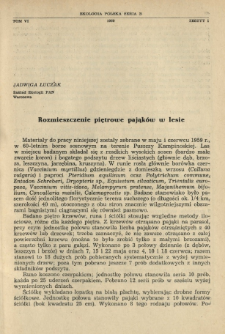- Wyszukaj w całym Repozytorium
- Piśmiennictwo i mapy
- Archeologia
- Baza Młynów
- Nauki przyrodnicze
Wyszukiwanie zaawansowane
Wyszukiwanie zaawansowane
Wyszukiwanie zaawansowane
Wyszukiwanie zaawansowane
Wyszukiwanie zaawansowane

Obiekt
Tytuł: Rozmieszczenie piętrowe pająków w lesie
Inny tytuł:
Distribution of spiders in the different strata of the pine wood
Współtwórca:
Polska Akademia Nauk. Komitet Ekologiczny
Wydawca:
Miejsce wydania:
Opis:
Strony 39-50 ; 24 cm ; Bibliografia na stronie 49 ; Streszczenie w języku angielskim
Typ obiektu:
Abstrakt:
The work was carried out in the big forest of Kampinos near Warsaw, in the period from May till June in the environment of sparsely wooded, 60 years old pine forest with a rich undergrowth of leafy trees and Vaccinium myrtillus in the herb layer. Spiders from shrubs, herb layer and litter were caught with methods such as: beating from the trees, sweeping by means of the sweep net and searching through the litter, taking in generał within the above mentioned period 49 quantitative samples from all three layers. The aim of this work was a preliminary examination of the distribution of various species of spiders and their quantitative proportions on different strata of wood. A total of 86 species (Table I) was caught and 1588 individuals belonging to 12 families, 70 species of which included adult individuals. Species notable for their large quantities, common for two strata are not encountered (Table II and III).Theridion ovatum is the only exception. This is evidence of the distinct division of the species of spiders among seperate strata. 2 dominant species (Trematocephalus cristatus and Theridion varians) and 4 influents (Anyphaena accentuata, Theridion ovatum, Araneus cucurbitinus, Theridion tinctum) were distinguished in the shrub layer, 3 dominant species (Linyphia triangularis, Theridion ovatum, Evarcha falcata) and 2 influents (Mangora acalypha and Dolomedes fimbriatus) in the herbaceous layer (Table V and VI).The following characteristics of structure of spider communities in shrub and herb layer were found. 1. Similarities: a. Numbers of dominant, influent and accessory species evidenced in percentages of the whole numbers of spiders of given layer show very approximate values. These are for shrubs: 47 + 14 + 39 = 100, for herbs: 46 + 11 + 43 =100.b. In both layers quantitative dominance is found of web spiders of the three following families: Linyphiidae, Argiopidae, Theridiidae (Table IV).2. Differences:a. In both strata different species are dominant (Table V and VI).b. The percentage of species equally distributed in both strata is very small, being lower than 18%.c. A larger quantity of adult individuals is to be found on shrubs than in the herbaceous layer. The herbaceous layer proves to be the habitat of young forms of spiders. Young forms are more than three times more numerous than adult ones.From the above mentioned characteristics of spider communities in shrub and herb layers it follows that the ecological structure of communities is alike in both strata but qualitative composition of communities and the age structure of the species are different.
Bibliografia:
1. Łuczak, J. 1959 - The community of spiders of the ground flora of pine forest - Ekol. Pol. A, 11.
2. Tretzel, E. 1954 - Reife und Fortpflanzungsszeit bei Spinnen - Z. Morph. Ökol. 42.
3. Wiehle, H. 1956 - Spinnentiere oder Arachnoidea (Araneae) 28. Familie Linyphiidae-Baldachinspinnen (Die Tierwelt Deutschlands 44) - Jena.
Czasopismo/Seria/cykl:
Tom:
Zeszyt:
Strona pocz.:
Strona końc.:
Szczegółowy typ zasobu:
Identyfikator zasobu:
oai:rcin.org.pl:120504 ; ISSN 0424-7205
Źródło:
MiIZ PAN, sygn. P.3259 ; kliknij tutaj, żeby przejść
Język:
Język streszczenia:
Prawa:
Licencja Creative Commons Uznanie autorstwa 3.0 Polska
Zasady wykorzystania:
Zasób chroniony prawem autorskim. [CC BY 3.0 PL] Korzystanie dozwolone zgodnie z licencją Creative Commons Uznanie autorstwa 3.0 Polska, której pełne postanowienia dostępne są pod adresem: ; -
Digitalizacja:
Muzeum i Instytut Zoologii Polskiej Akademii Nauk
Lokalizacja oryginału:
Biblioteka Muzeum i Instytutu Zoologii PAN
Dofinansowane ze środków:
Dostęp:
Kolekcje, do których przypisany jest obiekt:
- Repozytorium Cyfrowe Instytutów Naukowych > Kolekcje Partnerów > Muzeum i Instytut Zoologii PAN > Czasopisma
- Repozytorium Cyfrowe Instytutów Naukowych > Piśmiennictwo > Czasopisma/Artykuły
Data ostatniej modyfikacji:
4 lut 2025
Data dodania obiektu:
14 kwi 2020
Liczba pobrań / odtworzeń:
166
Wszystkie dostępne wersje tego obiektu:
https://rcin.org.pl./publication/98141
Wyświetl opis w formacie RDF:
Wyświetl opis w formacie RDFa:
Wyświetl opis w formacie OAI-PMH:
| Nazwa wydania | Data |
|---|---|
| Z. 1. Rozmieszczenie piętrowe pająków w lesie / Łuczak J. | 4 lut 2025 |
Obiekty Podobne
Łuczak, Jadwiga
Łuczak, Jadwiga
Łuczak, Jadwiga
Kajak, Anna Łuczak, Jadwiga

 INSTYTUT ARCHEOLOGII I ETNOLOGII POLSKIEJ AKADEMII NAUK
INSTYTUT ARCHEOLOGII I ETNOLOGII POLSKIEJ AKADEMII NAUK
 INSTYTUT BADAŃ LITERACKICH POLSKIEJ AKADEMII NAUK
INSTYTUT BADAŃ LITERACKICH POLSKIEJ AKADEMII NAUK
 INSTYTUT BADAWCZY LEŚNICTWA
INSTYTUT BADAWCZY LEŚNICTWA
 INSTYTUT BIOLOGII DOŚWIADCZALNEJ IM. MARCELEGO NENCKIEGO POLSKIEJ AKADEMII NAUK
INSTYTUT BIOLOGII DOŚWIADCZALNEJ IM. MARCELEGO NENCKIEGO POLSKIEJ AKADEMII NAUK
 INSTYTUT BIOLOGII SSAKÓW POLSKIEJ AKADEMII NAUK
INSTYTUT BIOLOGII SSAKÓW POLSKIEJ AKADEMII NAUK
 INSTYTUT CHEMII FIZYCZNEJ PAN
INSTYTUT CHEMII FIZYCZNEJ PAN
 INSTYTUT CHEMII ORGANICZNEJ PAN
INSTYTUT CHEMII ORGANICZNEJ PAN
 INSTYTUT FILOZOFII I SOCJOLOGII PAN
INSTYTUT FILOZOFII I SOCJOLOGII PAN
 INSTYTUT GEOGRAFII I PRZESTRZENNEGO ZAGOSPODAROWANIA PAN
INSTYTUT GEOGRAFII I PRZESTRZENNEGO ZAGOSPODAROWANIA PAN
 INSTYTUT HISTORII im. TADEUSZA MANTEUFFLA POLSKIEJ AKADEMII NAUK
INSTYTUT HISTORII im. TADEUSZA MANTEUFFLA POLSKIEJ AKADEMII NAUK
 INSTYTUT JĘZYKA POLSKIEGO POLSKIEJ AKADEMII NAUK
INSTYTUT JĘZYKA POLSKIEGO POLSKIEJ AKADEMII NAUK
 INSTYTUT MATEMATYCZNY PAN
INSTYTUT MATEMATYCZNY PAN
 INSTYTUT MEDYCYNY DOŚWIADCZALNEJ I KLINICZNEJ IM.MIROSŁAWA MOSSAKOWSKIEGO POLSKIEJ AKADEMII NAUK
INSTYTUT MEDYCYNY DOŚWIADCZALNEJ I KLINICZNEJ IM.MIROSŁAWA MOSSAKOWSKIEGO POLSKIEJ AKADEMII NAUK
 INSTYTUT PODSTAWOWYCH PROBLEMÓW TECHNIKI PAN
INSTYTUT PODSTAWOWYCH PROBLEMÓW TECHNIKI PAN
 INSTYTUT SLAWISTYKI PAN
INSTYTUT SLAWISTYKI PAN
 SIEĆ BADAWCZA ŁUKASIEWICZ - INSTYTUT TECHNOLOGII MATERIAŁÓW ELEKTRONICZNYCH
SIEĆ BADAWCZA ŁUKASIEWICZ - INSTYTUT TECHNOLOGII MATERIAŁÓW ELEKTRONICZNYCH
 MUZEUM I INSTYTUT ZOOLOGII POLSKIEJ AKADEMII NAUK
MUZEUM I INSTYTUT ZOOLOGII POLSKIEJ AKADEMII NAUK
 INSTYTUT BADAŃ SYSTEMOWYCH PAN
INSTYTUT BADAŃ SYSTEMOWYCH PAN
 INSTYTUT BOTANIKI IM. WŁADYSŁAWA SZAFERA POLSKIEJ AKADEMII NAUK
INSTYTUT BOTANIKI IM. WŁADYSŁAWA SZAFERA POLSKIEJ AKADEMII NAUK




































